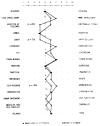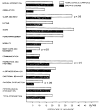Nonalcoholic cirrhosis associated with neuropsychological dysfunction in the absence of overt evidence of hepatic encephalopathy
- PMID: 6714571
- PMCID: PMC2963938
Nonalcoholic cirrhosis associated with neuropsychological dysfunction in the absence of overt evidence of hepatic encephalopathy
Abstract
Although much is known about the neuropsychological functioning of cirrhotic individuals with Laennec's (alcohol associated) cirrhosis, little is known about the neuropsychological functioning of individuals with nonalcoholic cirrhosis. In the present investigation, we have determined that individuals suffering from chronic nonalcoholic cirrhosis, despite the absence of clinical signs of hepatic encephalopathy, are impaired on neuropsychological tests that measure visuopractic capacity, visual scanning, and perceptual-motor speed. In contrast, intellectual, language, memory, attentional, motor, and learning abilities are intact. In comparison with a chronically ill control group of patients suffering from Crohn's disease, individuals with advanced nonalcoholic cirrhosis exhibit less emotional disturbance, but are more impaired in their daily activities. These findings indicate that individuals with nonalcoholic cirrhosis, even in the absence of overt clinical signs of encephalopathy, manifest neuropsychological impairments and experience significant disruption in the routines of everyday living.
Figures



Similar articles
-
Encephalopathy in patients with cirrhosis of the liver. A neuropsychological study.Scand J Gastroenterol. 1978;13(2):241-7. doi: 10.3109/00365527809181755. Scand J Gastroenterol. 1978. PMID: 635463
-
Memory impairments concomitant with nonalcoholic cirrhosis.Int J Neurosci. 1987 Feb;32(3-4):853-9. doi: 10.3109/00207458709043340. Int J Neurosci. 1987. PMID: 3596928
-
Development of a three-factor neuropsychological approach for detecting minimal hepatic encephalopathy.Liver Int. 2010 Jul;30(6):841-9. doi: 10.1111/j.1478-3231.2010.02246.x. Epub 2010 Apr 15. Liver Int. 2010. PMID: 20412441
-
Minimal hepatic encephalopathy.J Assoc Physicians India. 2009 Nov;57:760-3. J Assoc Physicians India. 2009. PMID: 20329443 Review.
-
Sarcopenia and cognitive impairment in liver cirrhosis: A viewpoint on the clinical impact of minimal hepatic encephalopathy.World J Gastroenterol. 2019 Sep 21;25(35):5257-5265. doi: 10.3748/wjg.v25.i35.5257. World J Gastroenterol. 2019. PMID: 31558871 Free PMC article. Review.
Cited by
-
The cognitive profile of depressed patients with cirrhosis.Prim Care Companion CNS Disord. 2011;13(3):PCC.10m01090. doi: 10.4088/PCC.10m01090. Prim Care Companion CNS Disord. 2011. PMID: 21977378 Free PMC article.
-
Breath-ammonia testing of healthy subjects and patients with cirrhosis.Dig Dis Sci. 2012 Jan;57(1):189-95. doi: 10.1007/s10620-011-1858-9. Epub 2011 Aug 13. Dig Dis Sci. 2012. PMID: 21842240
-
Diagnosis of Minimal HE-And the Temptation of Easy Solutions.J Clin Exp Hepatol. 2012 Dec;2(4):303-5. doi: 10.1016/j.jceh.2012.11.001. J Clin Exp Hepatol. 2012. PMID: 25755451 Free PMC article. No abstract available.
-
Associations between nut intake, cognitive function and non-alcoholic fatty liver disease (NAFLD) in older adults in the United States: NHANES 2011-14.BMC Geriatr. 2021 May 17;21(1):313. doi: 10.1186/s12877-021-02239-1. BMC Geriatr. 2021. PMID: 34001034 Free PMC article.
-
Evaluation of neuropsychological function in patients with liver cirrhosis with special reference to their driving ability.Metab Brain Dis. 1995 Sep;10(3):239-48. doi: 10.1007/BF02081029. Metab Brain Dis. 1995. PMID: 8830284
References
-
- Gilberstadt S, Gilberstadt H, Zieve L, et al. Psychomotor performance deficits in cirrhotic patients without overt encephalopathy. Ann Intern Med. 1980;140:519–21. - PubMed
-
- Rikkers L, Jenko P, Rudmen D, et al. Subclinical hepatic encephalopathy: detection, prevalence, and relationship to nitrogen metabolism. Gastroenterology. 1978;75:462–9. - PubMed
-
- McClain C. When liver disease causes brain damage. Geriatrics. 1980;198:74–89. - PubMed
-
- Goldstein S, Deysach R, Kleinknucht R. Effect of experience and amount of information on identification of cerebral impairment. J Consult Clin Psychol. 1973;41:30–4. - PubMed
-
- Atkinson M, Goligher J. Recurrent hepatic coma by colectomy and ileorectal anastomosis. Lancet. 1960;i:461–4.
Publication types
MeSH terms
Grants and funding
LinkOut - more resources
Full Text Sources
Medical

